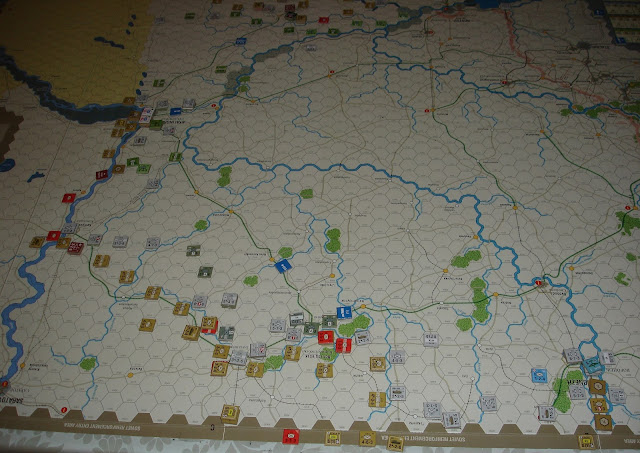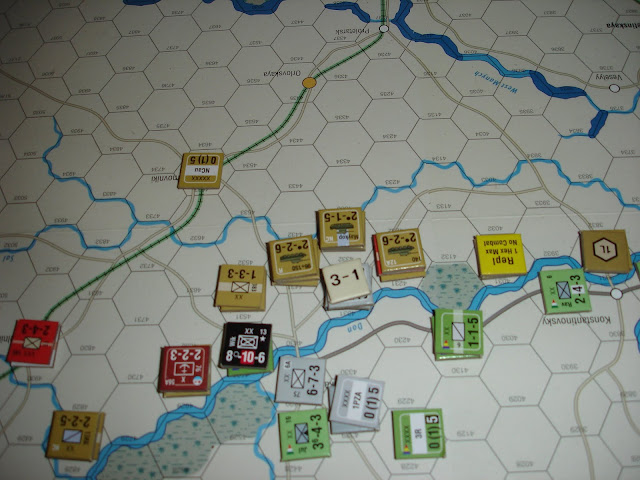This time I went the Commonwealth and Mark Woods, in only his second Rommel game, went Axis.
A bit of background to the battle first:
In July 1942 there were six battles fought around the Alamein line, followed ultimately by the November 1942 Battle of El Alamein under Montgomery after which the Eighth Army never lost another battle.
Auchinleck's third offensive had failed - and failed disgracefully. "There is nothing in the whole record of the Afrika Korps" states Ronald Lewin bluntly, "to compare with the abandonment of the New Zealanders naked before an armoured attack in the opening stages of the first Ruweisat battle."
This remark refers to other New Zealand brigades, and not the 6th Brigade, which would be called into action for the Second Battle of Ruweisat Ridge.
There would be even greater waste in Auchinleck's fourth offensive, the Second Battle of the Ruweisat Ridge, which began in the evening of 21 July. Its objective was declared to be "cutting Rommel's battle front in two parts."
The main assault was again to be carried out by XIII Corps. 6th New Zealand Brigade would attack from the south against the El Mreir Depression lying to the south-west of the Ruweisat Ridge, while 161st Indian Motor Brigade from the 5th Indian Division attacked from the east. The infantry would be assisted by 1st Armoured Division. The armoured brigades were not, however, intended to advance before first light on 22 July. Much criticism has been levelled against their commanders for being unwilling to move at night when the Germans had no compunction about doing so, but there was the important difference that the British tanks would have to make their way through enemy minefields.
In addition to their other tasks, 6th New Zealand and 161st Indian Motor Brigades were to clear a gap in those minefields.
Such was the plan, but not the realization. During the night of 21-22 July, 161st Brigade seized Deir el Shein, only to be driven out by counter-attack; it failed to capture Point 62. 6th New Zealand Brigade, after ferocious fighting which cost it 200 casualties, secured the eastern part of El Mreir, but the tanks did not move up to support it in time. In consequence at 0515 on 22 July, Nehring fell on the New Zealanders with both 15th and 21st Panzer and shattered them. Some 700 men were killed, wounded or captured, and twenty-three guns were lost.
Source:
http://nzetc.victoria.ac.nz/tm/scholarly/tei-GreLong-t1-body-d5.html
After Action Report
This time the Indians and New Zealanders made a dash using road movement and the associated event to untip to secure all four objectives.
The Axis immediately started to attack.
Point 62?
The New Zealanders were most exposed as they had no armour support.
The previous and following objectives represent the El Mreir Depression I expect.
Help Britain do the job - exactly!
On the isolated flank the Indians came under pressure.
But at the other locations the troops had been able to dig in.
The tank might be vulnerable, but it provides outflanking.
This objective I believe to be Deir el Shein.
The isolated Indians are dwindling.
The attacks are relentless.
The New Zealanders are holding on.
But you can hear them crying out for armour support.
The Valentines arrive.
21st Panzer pulls back its armour to a line,
but its panzergrenadiers continue to attack.
The newly arrived armoured brigade still has a good way to go before it can be of use.
The New Zealanders on the right are just about gone/
But in goes a counterattack to retake the central objective.
DAK reinforcements have arrived
and a major attack is being made against the remaining New Zealand position.
15th Panzer attacks the British armour.
21st Panzer has secured one objective and is now on the attack.
The British armour is not holding up very well.
But it is still getting stuck into the 15th Panzer.
But is really no match for them.
Back in the centre the British armour is still in control of the objective,
but for how long?
The New Zealanders have lost their objective.
The game now stands at a draw.
21st Panzer try to capture the remaining objective,
which is still gallantly held by the 161st Indian Motor Brigade.
However the central objective was lost and so Auchinleck's offensive is again stopped.

























































